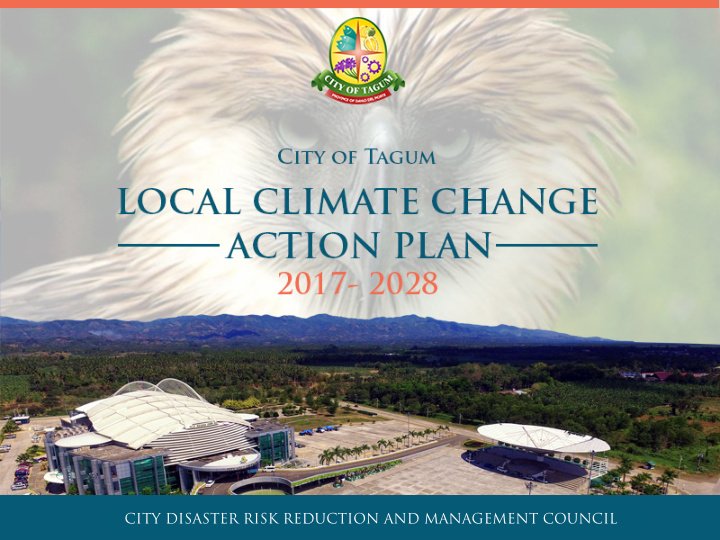



CITY DISASTER RISK REDUCTION AND MANAGEMENT COUNCIL
1 ST Class Component City Class: TAGUM Capital of the Province of Davao del Norte CITY Area: 19,580 hectares 59% dedicated to Agricultural Use Population: 259,444 Barangays: 23 Functional Role: Regional Center for Trade and Commerce (Davao Region RDP) Sources: PSA, Davao Regional Development Council
LOCATION AND GEOPHYSICAL FEATURES
Topography: Generally flat with rolling portions in the northern Part of the City
Hydrogeology: Recent Alluvium Acquifer consist of outwash, valley fill, river and coastal deposits of clay, silt, sand and gravel, corals and other marine carbonates. These unconsolidated, partly compacted deposits are less than 1 – 20 meters thick. Depth to water is from 0 to less than 10 meters below land surface Sources: DIDP, JICA
River System: 2 Major River Systems: Liboganon River Hijo River Commonly, outfall areas in the City are drained into the Davao gulf which also serves as the major outfall area of the municipalities and cities surrounding the gulf. Source: MGB
Land Use Tagum’s physical development has generally followed a multi-nodal pattern based on the 2011 – 2025 Comprehensive Land Use Plan. The plan should be able to pro vide adequate spaces to ensure that the city will accommodate future expansion of its urban areas and absorb the space requirement for commercial, institutional and industrial development. Source: Tagum City GIS Unit
Climate Level IV - rainfall is more or less evenly distributed throughout the year. 2020 Projection - Rainfall: reduction of rainfall during summer and habagat seasons and a slight increase during amihan season 2020 Projection – Temperature: increase will range from 0.9 ⁰ C to 1.20 ⁰ C and by 2050, from 1.90 ⁰ C to 2.5 ⁰ C. Source: PAGASA
Tagum City’s Climate Change Action Plan is a 12- year plan that will help the city become climate change adaptive and resilient
Goals: 1. building the adaptive capacities of men and women in their communities; 2. increasing the resilience of vulnerable sectors and natural ecosystems to climate change; and 3. optimizing mitigation opportunities towards gender- responsive and rights-based sustainable development.
Objectives: 1. to ensure availability, stability, accessibility and affordability of safe and healthy food amidst climate change; 2. to ensure the resilience of water resources, manage supply and demand, manage water quality and promote conservation; 3. to protect and rehabilitate critical ecosystems and restore ecological services; 4. to reduce the risks of women and men to climate change and disasters;
Objectives Con’t: 5. to create green and eco-jobs and sustainable consumption and production; 6. to promote and expand energy efficiency and conservation and develop sustainable and renewable energy, environmentally sustainable transport; and 7. to enhance the knowledge on climate change, capacity for climate change adaptation, mitigation and disaster risk reduction
LCCAP Framework
Situational Analyses Hazards and Disasters • Flood • Landslide (Rain induced) • Sea-level Rise • Storm Surge • Earthquake Related Hazards • Liquefaction • Tsunami
Historically, flooding and landslide are frequent in the city with an estimated occurrence of once every 1-3 years and sea level rise affects the communities at a very minimal prevalent rate while the rest of the identified hazards are just potential in the locality.
Exposed Elements Population Natural Resource Urban Use Based Production Areas Areas Critical Point Lifeline Facilities Utilities
Summary of Estimated Exposed Elements by Potential Hazard Exposed Element Potential Natural-based Critical Point Hazard Population Production Areas Urban Use Areas Lifeline Utilities Facilities Ø 11 schools (both public elementary and high schools) Ø 278.01 Has. - 44,510 or 6106.12 hectares Ø 5.21 kilometers residential Ø 6 barangay halls about 17 or 53 percent of National Roads Ø 12.88 Has. - and covered percent of the the total Ø 27.67 kilometers Flooding agri-industrial courts total agriculture land City Roads Ø 3.68 Has. – Ø 5 Day Care population use Ø 3 Bridges Centers cemetery Ø 6 Barangay Health Stations Ø 4 public elementary schools Ø 46.16 Has. - Ø 4.03 kilometers Ø 3 barangay halls residential National Road 8,188 1,225.69 and covered Landslide Ø 23.85 Has. - Ø 1.72 kilometers population hectares courts industrial/ City Roads Ø 3 Day Care agri-industrial Ø Electric Posts Centers Ø 3 Barangay Health Stations
Summary of Estimated Exposed Elements by Potential Hazard - continued Exposed Element Potential Natural-based Critical Point Hazard Population Production Urban Use Areas Lifeline Utilities Facilities Areas Sea Level 1 public elementary 0.89 kilometer city 173.13 hectares - Rise school road 3 public elementary Ø schools Ø 1 barangay hall and Ø 8.60 kilometers Storm Surge/ 2,551 524.61 hectares 11.76 Has. - residential covered court city roads Tsunami population 1 Day Care Center electric posts Ø Ø 1 Barangay Health Ø Station 5.23 kilometers Ø Ø New City Hall National Roads Ø 2 public elementary 3.62 kilometers Ø 561.97 Has. - schools Ø City Roads Liquefaction 26,370 residential 2 barangay halls Ø 1203.07 hectares Ø 2 Bridges population 4.50 Has. - agri- 1 covered court Ø Ø 1 Pumping Station Ø industrial Ø 2 Day Care Centers Bulk Water Project Ø Ø 2 Barangay Health 3 Cellsite Towers Ø Stations Ø Electric posts
Vulnerability Assessment Average Degree of Average Adaptive Relative Exposed Element Impact Capacity Vulnerability Population 1.88 2.17 4.07 Natural Production Area 1.89 2.15 4.07 Urban Use Area 1.95 2.06 4.00 Critical Point Facilities 1.63 1.88 3.06 Lifeline Utilities 2.18 2.25 4.91 Average 4.02
LCCAP: Issues, Challenges, and Priorities ISSUES Remarks For capacity building of 1 No Training Needs Assessment personnel 2 No approved LCCAP still a draft 3 Identification of LCCAP Technical Working Group to be revisited 4 No GHG Emissions Inventory 5 Environmental Code SP Committee Level 6 Mainstreaming of CDRA in the CLUP On process of integration 7 Not updated Comprehensive Development Plan 8 No approved Shelter Plan 9 No approved Drainage Master Plan 10 No Sewerage System major environmental concerns 11 Soil Erosion along riverbanks
Recommend
More recommend